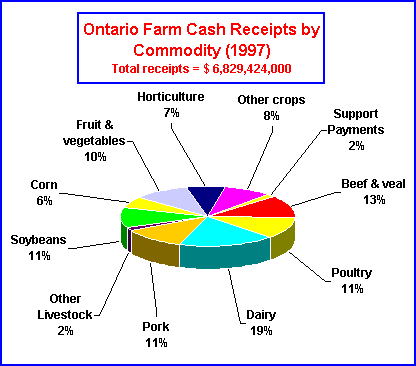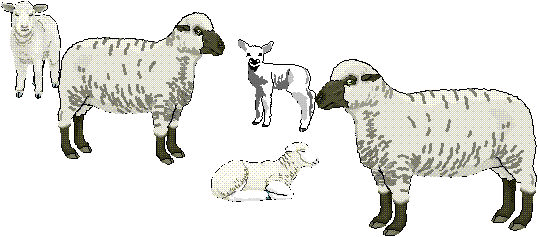
Humans keep domesticated animals because they provide something of value. Important but frequently overlooked contributions include draft power, manure, fibers, hides and other by-products. Livestock's most universal and significant productivity is, however, in terms of milk, meat and/or eggs for direct consumption by the animal owners or for sale to others.
| "Man is a carnivorous
production, And must have meals, at least one meal a day; He cannot live, like woodcocks, upon suction, But like the shark and tiger, must have prey; Although his anatomical construction Bears vegetables, in a grumbling way, Your laboring people think beyond all question, Beef, veal and mutton better for digestion." Byron, Don Juan, Canto II, St. 67. |
Diets based on meat, eggs and dairy products contain proteins,
carbohydrates, fats, minerals and vitamins present in appropriate amounts and
readily digestible forms to meet all human nutritional requirements. In the
past, animal protein was considered essential in human diets but recent
knowledge suggests that this is not absolutely true. A highly diversified
vegetarian diet can also provide all necessities but these may be obtained more
readily through consumption of some animal products. It must be conceded,
however, that most people enjoy eating meat and dairy products and do so by
choice rather than through absolute necessity.
| Mammalian species such as cattle, pigs, goats, sheep, equines, yaks, cameloids, buffaloes, reindeer and poultry yield substantial consumable commodities. The number of contributors becomes larger when exotic birds such as ostriches, guinea fowl, pheasants, quail, pigeons and Cornish hens are included and expands even further with poikilotherms such as fresh or salt water fish, shrimp, lobsters, crabs, oysters, mussels, squid, clams, scallops, frogs, turtles and even honey bees. The total contributions from domesticated animals, while not approaching the proportions derived from plants, are still quite large, providing approximately 34% of human food protein and 16% of food energy supply. |
|
|||||||||||||||||||||||||||
Developed countries have about one-third of the world's livestock but these produce somewhere between two-thirds and three-quarters of all products that pass through organized markets. Thus, substantial disparity exists between regions in the relative contribution of plant and animal products towards satisfying human energy and protein requirements. The actual contribution of animals to human protein intake varies from over 50% in Europe, Oceania and north America to less than 20% throughout most of Africa and in many Asian countries.
Total global marketing of consumable livestock commodities continues to grow annually, as shown in the following figure. Much of this recent growth is due to substantial output increases for pork and poultry occurring each year in China and other southeast Asian countries. One should be aware that the recorded figures usually represent volumes passing through organized marketing channels and thus available for collection by government agencies. Those amounts consumed directly or bartered by families engaged in subsistence agriculture are probably omitted. While this quantity would be negligible in the more developed countries, it could represent substantial amounts in other regions.

Agriculture in Canada and Ontario. Although the Canadian population is primarily urban, agriculture and the associated industries are still major contributors towards the economy of all provinces. Farming provides large volumes of food for both the domestic and export markets plus raw materials for the processing, wholesale and retail trades. Livestock sales account for over half of the total income received by Canadian farmers. For 1996 the sale of cattle accounted for a relatively large share (40%) of total livestock revenue with dairy (23%), pigs (19%) and poultry (15%) accounting for most of the remainder.
While the number of people actually working on farms in Ontario is small, the total agrifood industry in the province provides employment for a substantial proportion of the work-force. Total farm income for Ontario is now over six billion dollars annually with cash receipts for the major commodities shown in the accompanying chart. The sale of dairy, beef, pork, poultry and eggs accounts for over half of the total income. Also, a considerable portion of the "Other" income would be from activities such as aquaculture, honey, rabbits, fur, exotic species and other small volume animal farming enterprises. The most recent figures and a complete for all commodities can be obtained from OMAFRA.


Animal manure, although often referred to as a waste product in industrialized countries, is valuable for use as fuel, fertilizer or building material. Many Asian and some African livestock owners mix cattle, buffalo, yak or camel dung with straw and dry this into convenient-sized cakes or blocks for use as a cooking or heating fuel. Animal manure can be placed in fermentation chambers to generate methane gas and in some regions dung mixed with mud or clay forms building materials. Probably the most universal and principal use for manure is as fertilizer.